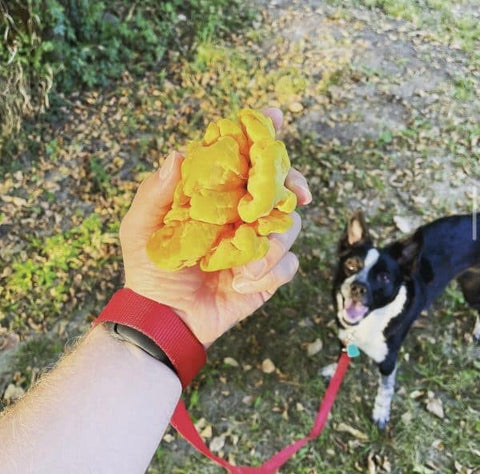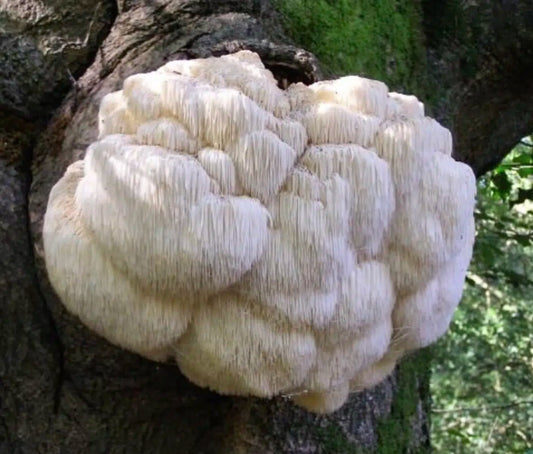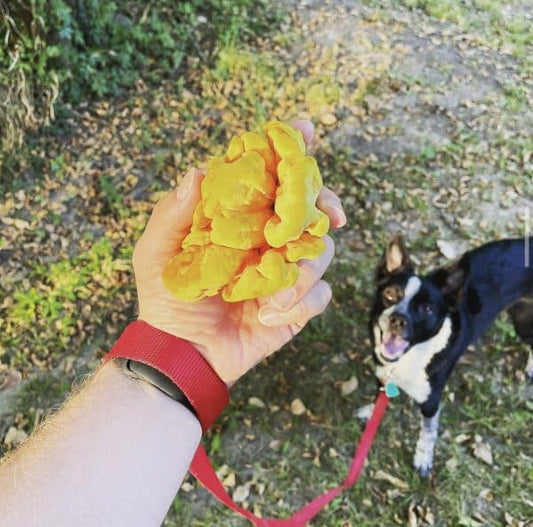Foraging for Mushrooms in Missouri – The Guide
Foraging for mushrooms in Missouri is a great way to enjoy the outdoors and benefit from an abundant source of food. The state we share is home to many wild mushroom varieties, from chanterelles, oyster mushrooms, chicken of the woods, hen of the woods, shaggy mane, morels, puffballs, and boletes. While picking mushrooms can be enjoyable, it is essential to educate yourself about safe mushroom harvesting practices before heading out on your foraging adventure.
Identifying mushrooms is the first step to foraging safely. There are many guides and identification books on foraging for mushrooms in Missouri available to help you correctly identify edible mushroom species. Also, it’s essential to be aware of poisonous look-alikes that grow in the same area as edible varieties. Familiarizing yourself with the common characteristics of edible mushrooms in your area can help you differentiate between the edible and the poisonous.
Foraging for Mushrooms in Missouri – Chantrelles
Chanterelles can be found growing in Missouri’s woods and forests during the spring, summer, and fall months. While they are not as commonly found as other types of mushrooms, they are worth searching for due to their delicious flavor.
When foraging for chanterelles in Missouri, it’s essential to be familiar with the different varieties of this mushroom. The most common types are the golden chanterelle (Cantharellus cibarius) and the white false chanterelle (Hygrophoropsis aurantiaca). The false chanterelle is bitter and rarely consumed. Chanterelles can often be found growing around dead trees or near decaying wood. They may also be found on the forest floor under leaves or grass clumps.
Chanterelles typically grow in clusters, but they may also appear alone. When harvesting chanterelles, it is best to leave the mycelium (the root structure) of the mushroom in place. This helps ensure that the mushrooms will continue to grow in the same area for years to come.
Foraging for Mushrooms in Missouri – Oyster Mushrooms
Oyster mushrooms (Pleurotus ostreatus) are one of the most popular edible mushrooms in Missouri. They can be found growing on dead or decaying wood, such as logs, stumps, and trees. Oysters vary greatly in color, ranging from white to dark brown. Their shape is often described as fan-shaped or like a cap that spreads over the substrate.
Oyster mushrooms are relatively easy to identify and are likely the most abundant edible mushroom in Missouri. They can be collected year-round in most areas, but they’re especially plentiful during rainy periods or after light showers. When you find these delicious morsels, simply slice them at the base to harvest them.
Read more about oyster mushrooms.
Foraging for Mushrooms in Missouri – Chicken of the Woods
When it comes to foraging for mushrooms in Missouri, the Chicken of the Woods (Laetiporus sulphureus) is an exciting find. This mushroom grows on dead or dying hardwood trees and stumps, and can often be found near oak, maple, elm, and beech. Typically found between May and November, Chicken of the Woods is easily identifiable by its bright yellow-orange color and graceful fan shape. The Chicken of the Woods has a mild, pleasant flavor and is often used as an ingredient in soups and other cooked dishes.
Foraging for Mushrooms in Missouri – Hen Of The Woods
The Hen of the Woods (Grifola frondosa), otherwise known as Maitake mushrooms, are large, delicious, and highly nutritious mushrooms that can be found growing at the base of oak trees throughout Missouri. Foragers may recognize them by their distinctive fan-shaped structure which resembles a hen’s tail feathers, hence the name.
Hen of the Woods mushrooms can be identified by their grayish-brown color and white undersides. They have a distinctly earthy flavor that is highly sought after by mushroom aficionados. When foraging for maitake mushrooms, it’s important to remember that they may look similar to other poisonous varieties.
Read more about Maitake mushrooms.
Foraging for Mushrooms in Missouri – Shaggy Mane
Shaggy Mane mushrooms (Coprinus comatus) are a type of edible mushroom native to Missouri. They can be found growing in grassy or wooded areas during the summer and fall seasons. The mushrooms have an unmistakable shaggy appearance with their white conical caps that can range from 2-6 inches in width. They also have a distinct appearance due to their white gills that turn black as the mushroom matures.
 Foraging for Mushrooms in Missouri – Morels
Foraging for Mushrooms in Missouri – Morels
Morel mushrooms (Morchella esculenta) is one of the most sought-after wild edibles in Missouri. With their distinct honeycomb-like caps, morels can be found in a variety of habitats throughout the state during the spring. When foraging for morels in Missouri, the best time to look is usually between April and May. Morels tend to prefer damp, wooded areas and can often be found near elm, ash, and apple trees.
Morels can be easily confused with other mushrooms that are poisonous so it’s best to brush up on proper identification techniques before you start foraging.
Once you’ve found a few morels it’s crucial to properly store them. Morels can be dried, frozen, or cooked right away. The best way to ensure the mushrooms don’t spoil is to store them in an airtight container in the refrigerator.
Foraging for Mushrooms in Missouri – Puffballs
Puffballs (Bovista aestivalis) are large, round mushrooms that can grow up to five inches in diameter. They have a smooth, skin-like surface with no visible gills or ridges on the outside. The flesh inside is also white and spongy to the touch. Puffballs are typically found in wooded areas, especially near oak trees, during late summer and early fall.
Foraging for Mushrooms in Missouri – Boletes
Bolete mushrooms, also known as “porcini” or “ceps”, are highly desired by mushroom hunters. Bolete species grow throughout Missouri and can be found in many types of habitats including hardwood forests, meadows, pastures, and even lawns. Boletes are recognizable by their fleshy caps with a porous under-surface, which is white or cream in color.
When foraging for boletes in Missouri, be familiar with the different species and their distinguishing characteristics. Some of the more commonly found boletes in Missouri include King Bolete (Boletus edulis), Slippery Jack Bolete (Suillus luteus), and the Scarletina Bolete (Neoboletus praestigiator). When foraging for boletes in Missouri, look for them in late summer and early fall.
Foraging for Mushrooms in Missouri – Identifying Poisonous Mushrooms
Missouri has an abundance of mushrooms growing throughout its forests and woodlands. However, it is vital to be aware that some mushrooms are poisonous and can cause serious illness or even death if consumed. It is essential to learn how to properly identify edible mushrooms so you can safely enjoy them.
When it comes to identifying mushrooms, there are a few key things to look for. To start, you should learn the differences between poisonous and non-poisonous mushrooms. Poisonous mushrooms can range from mild to deadly in toxicity, so you must be aware of which species are toxic before harvesting any wild mushrooms.
Common characteristics of poisonous mushrooms include a volva (a sack-like structure at the base of the cap), gills that are bright yellow or green, and a highly distinct odor. Additionally, some species of mushrooms may have small scales on their caps or stems which can be an indication of toxicity.
Furthermore, make sure you research the different species of mushrooms that grow in Missouri and learn how to properly identify them. The main poisonous mushrooms you will encounter in Missouri include the Destroying Angel, the Deadly Galerina, the Jack-o’-lantern mushroom, False Morels, and False Parasols. Some species of Boletes are also toxic.
Toxic Boletes
Some of the boletes are poisonous and should not be consumed. One of the toxic bolete species in Missouri is the Red-Mouth Bolete (Boletus subvelutipes).
False Morels
False Morels (Gyromitra esculenta), which have a brain-like shape, contain a toxin that can cause severe digestive issues, abdominal pain, confusion, loss of coordination, and even death if consumed.
False Parasol
The False Parasol (Chlorophyllum molybdites) is a poisonous mushroom found throughout Missouri. Its common name comes from its appearance, which resembles the edible parasol mushrooms. However, they are not related and can be distinguished by several features. The False Parasol has a white to brownish-gray cap with scales or warts on the top. The stem is white, and it produces thick, white gills on the underside. Its spore print is greenish-brown.
False Parasols are often found on lawns, golf courses, or other disturbed areas with plenty of sunlight, as well as in wood chips or mulch. They are usually found after rain between late spring and early fall.
False Parasols are poisonous, and eating them can cause symptoms such as vomiting, diarrhea, abdominal pain, and headache. Due to their resemblance to edible parasol mushrooms, mushroom enthusiasts must be able to recognize the False Parasol in order to avoid accidentally ingesting it.
Green-Spored Lepiota
Classified as a false parasol, the Green-Spored Lepiota mushroom (Chlorophyllum molybdites) also looks like an edible variety but contains a toxin that will cause severe gastrointestinal symptoms such as abdominal cramps and vomiting.
Jack-o’-lantern Mushrooms
Jack-o’-lantern mushrooms (Omphalotus illudens) look similar to an edible variety but are poisonous and can cause nausea, vomiting, abdominal pain, diarrhea, convulsions, coma, and rarely death.
The Deadly Galerina
The Galerina mushroom (Galerina marginata), also called the Autumn Skullcap, is a species of deadly poisonous mushroom found in Missouri. It often grows on decaying wood, especially from conifer trees such as pine and fir. The stem can be up to 2 inches long, and the cap may reach up to 4 inches in diameter with concentric grooves around the edge. This mushroom ranges in color from yellow to brown with a pale or white center.
The Galerina mushroom is especially known for its deadly toxicity due to the amatoxins it contains. These toxins can cause liver and kidney damage if ingested, and in some cases may lead to death. The symptoms usually appear 6-24 hours after consumption and may include severe vomiting, diarrhea, dizziness, headache, abdominal pain, and jaundice.
The best way to identify the Galerina mushroom is by its yellowish-brown cap with concentric grooves around the edge as well as its cylindrical white stem.
The Deadly Destroying Angel
The most dangerous mushroom of all is the Destroying Angel (Amanita bisporigera) which contains a powerful toxin that can be fatal if ingested. Symptoms usually start with nausea, vomiting, cramps, and diarrhea within a few hours of consumption and can lead to liver failure and even death in some cases. It’s essential to learn how to identify them properly so that you don’t put yourself at risk while foraging for mushrooms.
The Destroying Angel is white with a bulbous base and can range from 5-25cm high. The cap of the mushroom is pure white, often with faint concentric rings. The edges of the cap are smooth, convex, or flat in shape, and may have wavy margins. It has creamy white gills that are crowded closely together and run down the stem. The stem is also white, smooth, and filled with a cottony substance.
Destroying Angel mushrooms grow in clusters or rings near deciduous trees throughout Missouri during the summer and fall months. To avoid confusion with other similar species, pay close attention to the gills of the mushroom when foraging. Destroying Angel’s gills are creamy white and run down the stem in contrast to other poisonous mushrooms that have pink gills.
User Caution When Foraging for Mushrooms in Missouri
Never eat any mushroom that you are not 100% certain is edible. If in doubt, it is best to discard the mushroom and look for another batch of identified mushrooms. There are plenty of delicious and safe varieties of wild mushrooms that can be safely enjoyed when properly identified.
If you are not confident in your ability to identify mushrooms, consider taking a foraging class or seeking the advice of an experienced mushroom hunter.
Foraging for Mushrooms in Missouri – Foraging Books, Groups, and Societies
Many of the parks in Missouri offer classes on mushroom identification, and some even have their own local mycological societies. Additionally, there are many experienced guides who offer tours and workshops throughout the state.
One of the best books on the subject, Missouri’s Wild Mushrooms by Maxine Stone, is a must-have resource that is available on Amazon.
The Missouri Mycological Society is a great resource for mushroom hunters. The society offers classes, meetings, and field trips in the summer and fall months. Experienced guides help participants identify mushrooms, as well as provide advice on safe harvesting techniques.
Eating the Ozarks is another group that forages wild edibles. Not only do they specialize in foraging for mushrooms in Missouri, but they also teach primitive skills like camping, food preservation, and herbal medicine, in addition to offering foraging certificates.
First Earth Wilderness School teaches age-old survival techniques that include primitive skills and foraging techniques. They also sell a book called Foraging The Ozarks that can be used as a guide for anyone foraging for mushrooms in Missouri.
For a list of all 104 notable fungi found when foraging for mushrooms in Missouri, check out the Missouri Department of Conservation.
Foraging for Mushrooms in Missouri
Foraging for mushrooms in Missouri can be an enjoyable and rewarding experience with the right knowledge and precautions. With a little preparation and education, you can safely enjoy all that nature has to offer while gathering some delicious wild mushrooms.
In addition to foraging, if you want to grow your own Lion’s Mane or Oyster mushrooms from home, we offer kits to get you started.




